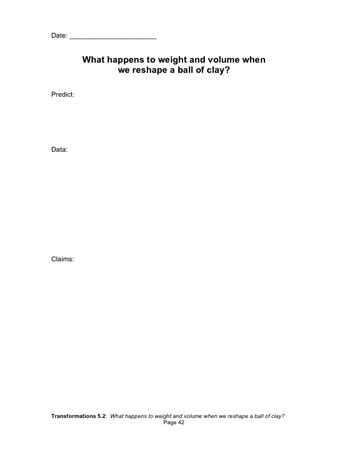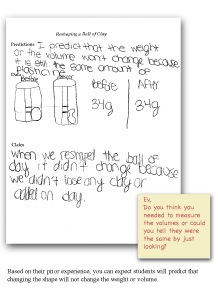What happens to weight and volume when we reshape a ball of clay?
Plan Investigation 5.2
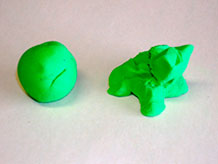
What if we take a ball of plastic modeling clay and mold it into the shape of an elephant? Does the weight stay the same? Does the volume?
Formative Assessment
Available online at inquiryproject.terc.edu
In this investigation, a companion piece for the previous one, students continue to explore what happens when earth materials are transformed. Instead of crushing shells, students this time manipulate a ball of plastic modeling clay, which serves as a stand-in for clay, a malleable earth material. Students record the weight and volume of a ball of plastic modeling clay, form it into a new shape of their own choosing, and then measure weight and volume again.
By the end of this investigation students will understand that plastic modeling clay or clay retains its weight and volume no matter what shape it assumes.
Learning Goals
- Discover what happens to weight and volume when clay changes shape
| Sequence of experiences | ||
|---|---|---|
| 1. Ask the question | All Class | 5 Mins |
| 2. Explore weight and volume | Pairs | 25 Mins |
| 3. Make meaning | Discussion | 15 Mins |
Materials and Preparation
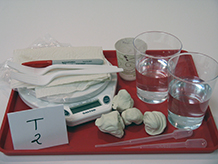
- Post the investigation question in a place where all students can see it.
- 1 tray of materials, as below, for class discussion
- 1 fine-tip permanent marker
- 1 digital scale
- 1 3oz cup of water
- 2 20oz cups approximately half full of water
- 2 forks
- 2 pipettes
- 4 balls of plastic modeling clay, approximately 30g each
- 4 paper towels
Notebook Pages
Do students understand that a ball of plastic modeling clay will weigh the same and displace the same volume of water no matter how it is reshaped?
The notebook will provide you with evidence of students’ understanding. Criteria you can use to interpret the entries are; Do students:
- predict that weight and volume will stay the same?
- use their measurements to support their claims?
- reason that if you don’t add plastic modeling clay or take it away, weight and volume should stay the same?
- do their measurements seem accurate?
Students may find small changes in weight (+/- 1 gram) after reshaping. Do students think this difference is significant? As a next step, you might look at class data and discuss possible sources of error such as inaccurate scales or forgetting to dry off the reshaped plastic modeling clay.
1. Ask the question
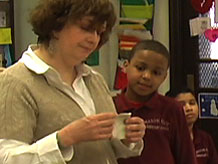
Recall the last investigation, when students crushed a handful of shells in a bag.
- What did we discover about the weight of the crushed shells?
- It was the same as the weight of the whole shells.
- What about the volume?
- It was also the same.
Now pass around the four balls of plastic modeling clay.
- What do you know about this material? What are some of its properties? How is it different from shell?
- soft vs. hard, squishy vs. breakable, man-made vs. natural, different colors, etc.
Brittle vs. malleable: The terms brittle and malleable may be new to some students. While they may be familiar with materials that are brittle (glass, pottery, chalk) or malleable (clay, plastic modeling clay), they may not be aware that these are properties of the material.
Plastic modeling clay is a lot like clay, a natural earth material. Unlike shell, which is brittle, plastic modeling clay and clay are malleable; they can be reshaped without snapping into tiny pieces.
- But what happens when we change the shape of the plastic modeling clay? If we squish the ball really tight, does it get heavier? If we roll it out really thin, does it have more volume — or less?
- If one of you makes a dog out of the plastic modeling clay and another makes a snake, which will weigh more? Which will have more volume?
- What if you break the ball into 25 little pieces? Will there be more volume or less? What about the weight?
Listen to all the suggestions, and let students argue if they have different ideas, but make no judgments. Instead, introduce the investigation question:
What happens to weight and volume when we reshape of a ball of clay?
Explain that this investigation is much like the last one. Students will each take a ball of plastic modeling clay, measure its weight and volume, change its shape, and measure again. But instead of crushing the material, as they did with the shells, they can change it into any shape they please.
2. Explore weight and volume
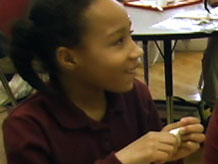
Distribute a tray of materials to each group. Ask volunteers to outline the steps to answer the investigation question. What data will they need to collect before and after changing the shape? What methods will they use? Write the steps on the board as students offer them, and then refine the sequence as necessary. In particular, explain the following two rules:
- Students must use all of the original material in the transformed shape; otherwise it is not a fair test.
- In order to check volume, students must be able to fit their new shape into the big cup and submerge it completely in the water; if they need to curl their shape to do this, that’s OK.
Give students a few minutes to record their predictions in their science notebooks [What happens to weight and volume when we reshape a ball of clay?], and then have them each transform a ball of plastic modeling clay into a shape — or a collection of shapes — of their own choosing.
Have students work through the procedure in pairs, everyone recording their own data in their notebooks as they go along. Students may try as many shapes as time allows.
As you circulate among the groups, ask students what they are thinking about how shape affects volume. If they are already certain that their new shape will not change the weight and volume of the plastic modeling clay, challenge them to try to find a shape that will.
A Likely Sequence of Investigation:
- Weigh the plastic modeling clay and record the weight in the notebook.
- Mark the starting water level in the big cup.
- Carefully lower the plastic modeling clay into the cup to determine how much water is displaced.
- Mark the new water level and record the information in your notebook.
- Remove the plastic modeling clay, dry it with a paper towel, and change its shape.
- Repeat the process with the new shape.
After students finish collecting and recording their data, have them record their claims in their notebooks and then share them within their small groups.
3. Make meaning
Purpose of the discussion
The purpose of the discussion is to construct an evidence-based explanation of what happens to weight and volume when a ball of clay is reshaped. Focus the discussion on the investigation question.
What about conflicting claims? Students should find that the weight and volume remain constant no matter what shape they make with the plastic modeling clay. If a conflicting claim arises in class, i.e., if someone claims that the weight or volume of their plastic modeling clay has indeed changed, lead a discussion of what might account for the finding. Could some of the plastic modeling clay have been lost in the transformation? Could there be a measurement error? Could the counterclaim in fact be correct? The student may wish to repeat the experiment with a new ball of plastic modeling clay to resolve the dispute. In any case, let students know that scientists sometimes do get different results from the same investigation. It's by sharing data that they resolve these differences.
Engage students in the focus question
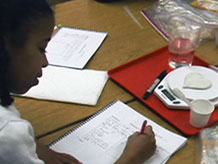
To engage students, have the investigation materials available and recalling the investigation question. Provide a minute for students to discuss the claim they would make and the evidence that supports it.
What happens to weight and volume when we reshape a ball of plastic modeling clay?
- What claims can you make? What is your evidence?
- Does this make sense to you? Why do you think the weight and volume stay the same when you change the shape?
Listen for the argument that weight and volume do not change because no material has been added or removed; the material has just been rearranged. If someone says that the new shape "looks" bigger or smaller, acknowledge that this may be so, ask the student to describe what the data say, and revisit the idea that we can’t always rely on our senses for measuring weight or volume.
Make a connection to the students' everyday life.
- Can you think of an example of crushing something and having the volume change? How would you explain this?
- The volume of the space inside an empty soda can will change when the can is crushed, but the volume and weight of the aluminum will remain the same.
- The bulk volume of a box of cornflakes will change if the contents settle. As with the soda can, it’s the volume of air that is reduced; the weight and volume of the cornflakes themselves remains the same.
Sometimes Volume Seems to Change: Solids and liquids are virtually incompressible. Squeezing them will not change their volumes or weights. Gases are a different story. Gases are compressible because their molecules are much more spread apart than those of solids or liquids, but this is not a topic you need to raise with students at this point.
Summarize the discussion
Use the same language that the students used to explain that weight and volume do not change because no material has been added or removed, only rearranged.
As you recap the investigation, check for understanding that when the shape of a malleable object changes, its weight and volume stay the same.


